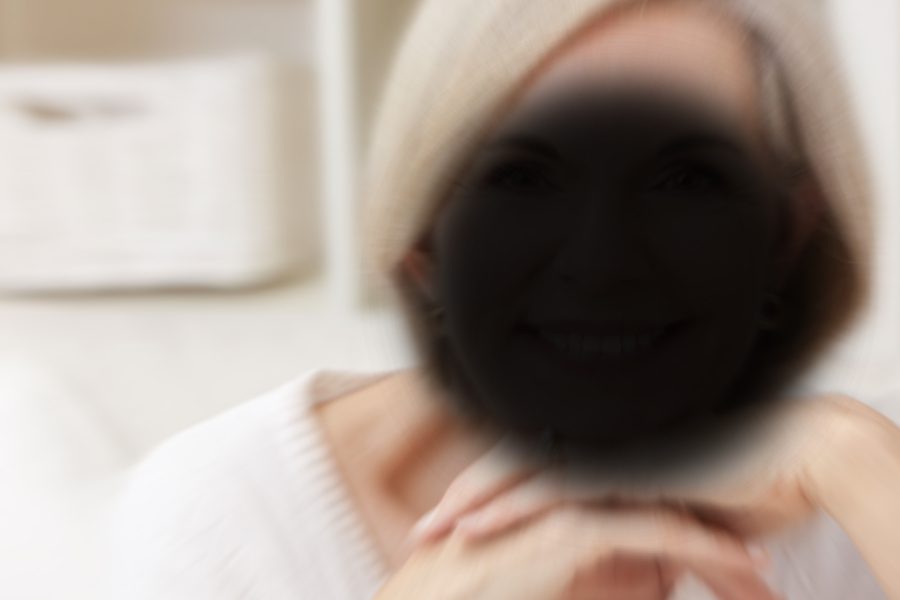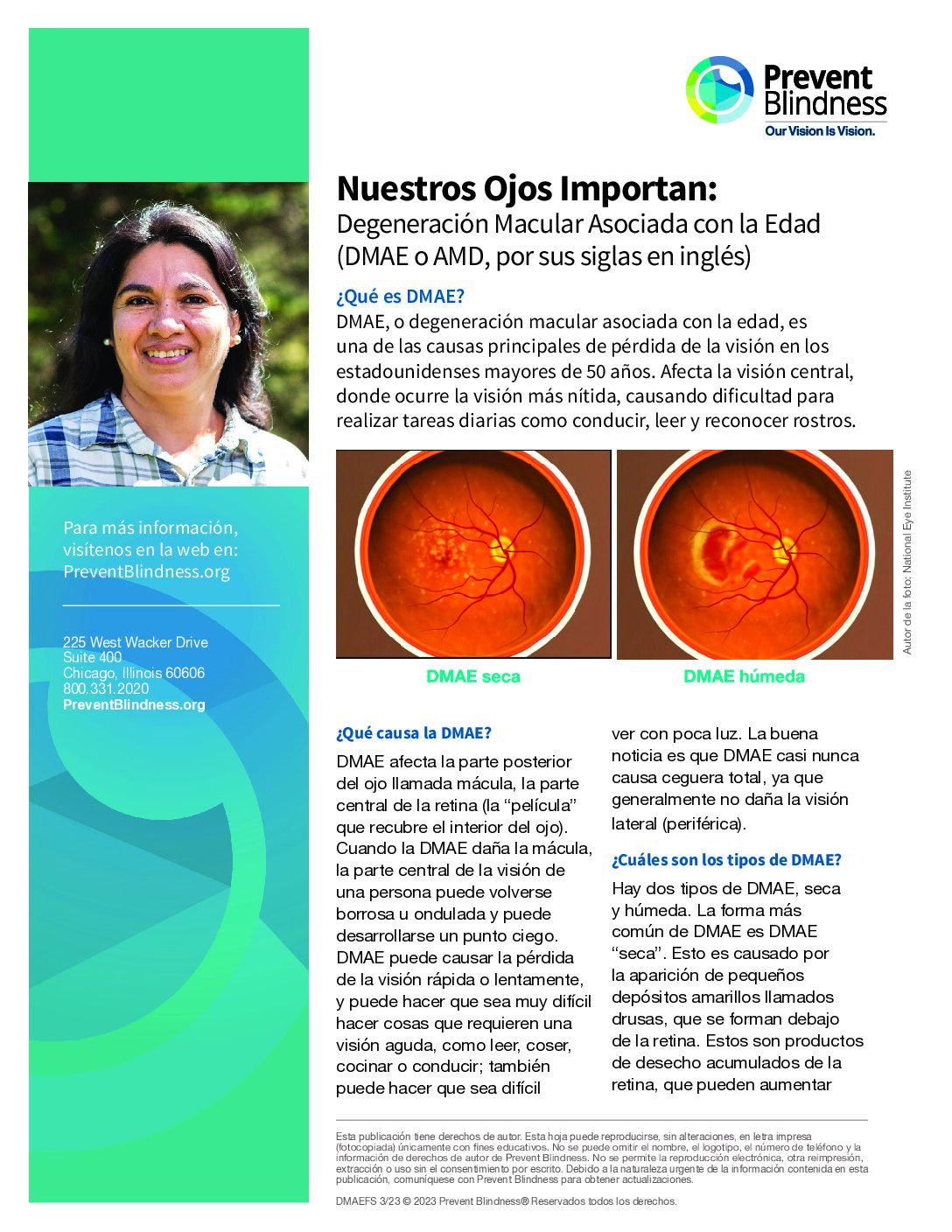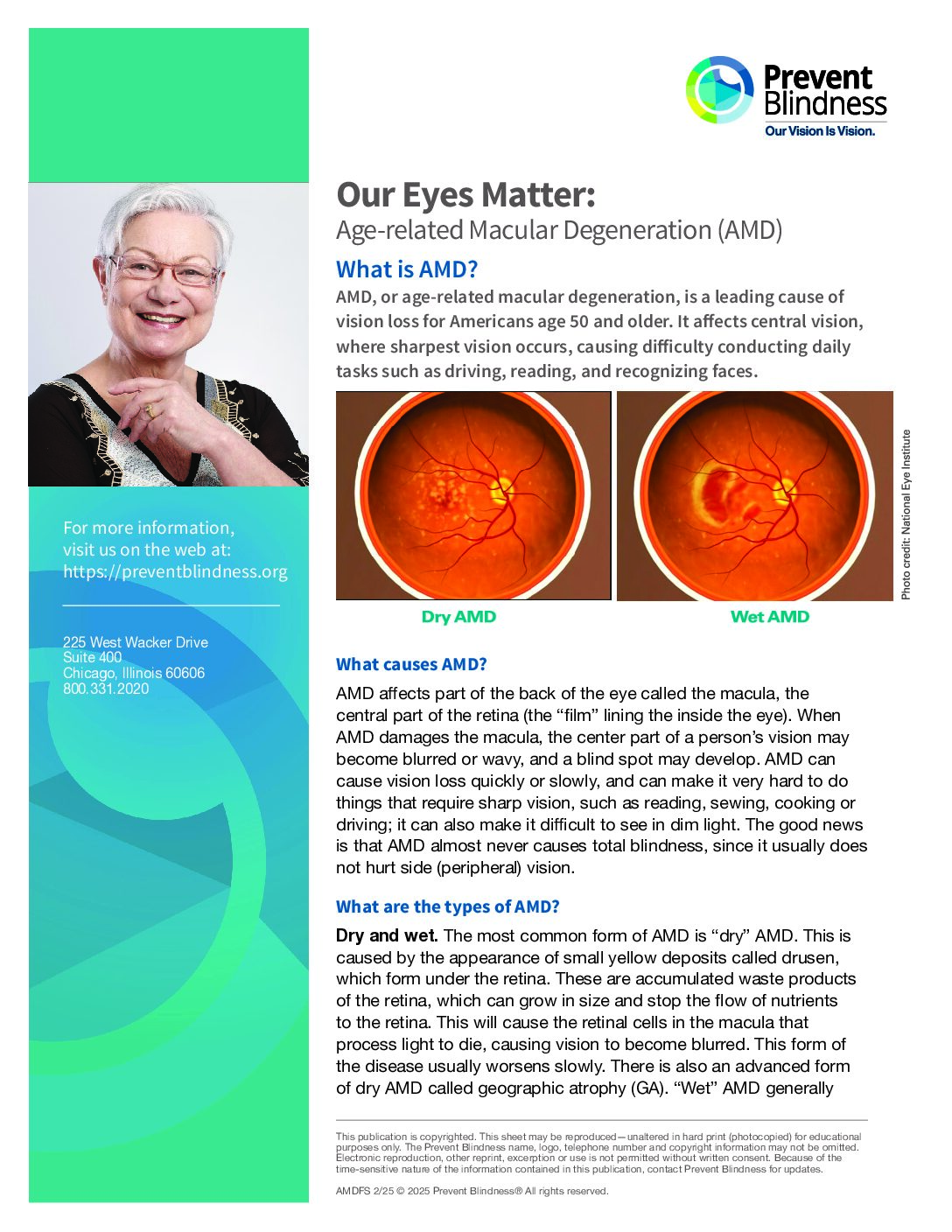What is AMD?
AMD, or age-related macular degeneration, is a leading cause of vision loss for Americans age 50 and older. It affects central vision, where sharpest vision occurs, causing difficulty conducting daily tasks such as driving, reading, and recognizing faces.
What causes AMD?
AMD affects part of the back of the eye called the macula, the central part of the retina (the “film” lining the inside of the eye). When AMD damages the macula, the center part of a person’s vision may become blurred or wavy, and a blind spot may develop. AMD can cause vision loss quickly or slowly, and can make it very hard to do things that require sharp vision, such as reading, sewing, cooking or driving; it can also make it difficult to see in dim light. The good news is that AMD almost never causes total blindness, since it usually does not hurt side (peripheral) vision.
What are the types of AMD?
Dry and wet. The most common form of AMD is “dry” AMD. This is caused by the appearance of small yellow deposits called drusen, which form under the retina. These are accumulated waste products of the retina, which can grow in size and stop the flow of nutrients to the retina. This will cause the retinal cells in the macula that process light to die, causing vision to become blurred. This form of the disease usually worsens slowly. “Wet” AMD generally causes more rapid and more serious vision loss. In this form of the disease, tiny new blood vessels grow under and into the retina. These blood vessels are fragile and often break and leak, causing a loss of vision. There is also an advanced form of dry AMD called geographic atrophy (GA).
What are the symptoms of AMD?
There may be no symptoms until the disease progresses or affects both eyes. Vision changes due to AMD are:
- Difficulty seeing in the center of your vision, which is needed for reading, sewing, cooking, looking at faces, and driving
- Trouble seeing in dim light
- Straight lines start to appear wavy, blurry or missing
- Fading and/or changes in the appearance of colors
If you experience any of these symptoms, see an eye doctor as soon as possible.


How is AMD diagnosed?
The key to slowing or preventing vision loss is regular eye exams. People age 60 or older should get a complete eye exam and follow-up with eye exams every one or two years or as indicated by the eye doctor. It is important to maintain a routine schedule of eye exams even if there are no noticeable vision problems.
During an eye exam, the eye doctor will conduct the following tests:
Visual acuity: This will determine how well a person can see through his or her central vision and if there is a decrease in visual acuity.
Dilated eye examination: The eye doctor will dilate (widen) the pupil of the eye, with eye drops to allow a closer look at the back of the eye. The doctor will look for buildup of drusen, new abnormal retinal blood vessels, and a breakdown of pigment and light-sensitive cells in the macula.
Amsler grid: This will test for problems in the macula. An Amsler Grid is made of straight horizontal and vertical lines. AMD may make the straight lines in the grid to appear faded, broken or wavy.
If the eye doctor suspects AMD, then the following tests may be conducted:
Optical coherence tomography (OCT): The OCT examination provides a cross sectional image of the eye, which can show if the macula is thickened and/or if fluid is leaking.
Fluorescein angiography: During this test, a dye is injected into the arm that “lights up” the blood vessels in the eye while multiple photos are taken of the back of the eye. These images will show if there are new blood vessels in macula and /or there is leaking of dye to determine if an individual has wet AMD.
How is AMD treated?
Currently, the only treatment for dry AMD, which in many people show no symptoms or loss of vision, is dietary vitamin and other supplements. A study has found that a certain combination of vitamins (vitamins C and E, lutein, zeaxanthin, and zinc), known as AREDS (Age Related Eye Disease Study) vitamins, can slow the progression of dry AMD in people with a moderate level of disease. However, these vitamins do not cure AMD. Only an eye doctor can tell if these will be of benefit.
Find out more about nutritional supplements and AMD.
The eye doctor may recommend a comprehensive dilated eye exam at least once a year. The exam will help determine if the condition is worsening.
The FDA has approved a treatment for GA. Additional treatments for GA are completing the clinical trial process. Learn more about clinical trials.
The treatment of wet AMD has changed rapidly over the past few years, and new research and treatments continue to be developed and tested. These mainly work by stopping the growth of new blood vessels and decreasing the leakage of these abnormal blood vessels.
- Anti-vascular endothelial growth factor (anti-VEGF) drugs and bispecific monoclonal antibody drugs: The current standard treatment, these drugs block the development of new blood vessels and limit the leakage from the abnormal blood vessels in the eye. They are delivered through an injection or implant into the eye, administered by an ophthalmologist, usually a retinal specialist. While some pressure will be felt during the injection, the eye is first numbed to minimize any discomfort. Several injections over time are needed in this treatment (frequency of injections varied based on the drug selected and the eye doctor’s judgment).
- Photodynamic therapy (PDT): Only used occasionally, PDT uses a laser beam with a light-sensitive dye to destroy unhealthy new blood vessels in or under the retina. Multiple treatments may be needed, as directed by the eye doctor.
- Laser photocoagulation: Only used occasionally, photocoagulation uses a stronger laser to destroy the new blood vessels. The treatment itself leaves permanent blind spots in a person’s vision. It helps to slow or stop the growth of new blood vessels that could damage vision even more and to preserve the vision that remains.
- Healthy Lifestyle: Healthy habits can lead to healthy eyes – quit smoking, eat healthy foods, and stay active. Talk to a doctor before starting an exercise program.
Prevent Blindness strongly recommends that individuals consult with their eye doctor to determine the best treatment options for them.
Living with Low Vision
If you or someone you know has lost some sight to AMD, low vision aids can help you stay independent. Special training, called vision rehabilitation, can provide skills for living with low vision. A low vision specialist will help determine the right combination of aids for your needs. Ask your eye doctor about the possibility of seeing a low vision specialist.
Low vision aids include:
- Magnifying glasses, screens and stands
- Telescopic lenses
- High-intensity reading lamps
- Large-print newspapers, magazines and books
- Close-circuit TVs that magnify a printed page on screen
- Computers and tablets
GuideMe for Age-Related Macular Degeneration
GuideMe is a free resource for those who have been recently diagnosed with AMD, their family members and caregivers. Learn more at guideme.preventblindness.org.
Living Well with Low Vision is an online resource to educate those with loss of vision on how maintain their independence and quality of life.
Learn more at lowvision.preventblindness.org.
Living with AMD
If you have age-related macular degeneration, you’re not alone. Nearly 2.1 million Americans aged 50 and older have age-related macular degeneration. There is much you can do to prevent vision loss from AMD and maintain your independence and quality of life while living with the disease.
Take Care of Yourself
Take care of yourself, physically and emotionally. Exercise, a healthy diet and regular eye care are an important part of staying healthy, whether or not you have AMD.
The emotional effects of AMD can be as serious as vision loss. Feelings of helplessness, anger, and depression are common when dealing with macular degeneration, so be sure to pay attention to your emotional health as well as your physical health.
AMD and Vision Loss
There are many things you can do to make your daily life easier even if you have lost much of your sight to AMD.
Special training, called vision rehabilitation, can give you skills for living with vision loss.
Low vision aids are tools that can help you if you have vision loss. Some of these tools are:
- magnifying lenses or special glasses
- closed-circuit TVs
- computers with large screens
- bright lamps, large-print books and magazines
Stay positive about the challenges of living with low vision. You may need to develop new skills for daily living. Learn as much as you can about resources and rehabilitation services that are available.
It’s common to feel anger, grief and depression when you have vision loss. Losing even part of your vision can be devastating. But stay determined and be persistent. You can make the most of your remaining vision. Know that much of what has to be done to keep your independence and quality of life must be done by you.
Check Your Vision with the Amsler Grid
If you have age-related macular degeneration, you must check the central vision in each of your eyes separately every day. If you notice any changes such as having trouble reading, or seeing straight lines that appear wavy, tell your eye doctor right away.
Amsler Grid
The purpose of this section is to check adults for Macular Degeneration using an Amsler Grid pattern.
Before you take this test, you should know the difference between an eye check or test and an eye exam done by an eye doctor.
Taking the Test
Macular Degeneration is a disorder at the back of the eye in which the central part of one’s vision is blocked as if a blurred area had been placed in the center of the picture. The image around the blurred area may be clearly visible. An abnormality in the appearance of the Amsler Grid pattern may indicate macular degeneration. If you notice any such abnormality, you should arrange for a professional eye exam. Please note that some people with AMD may not see a distortion on the Amsler grid.
Printable Amsler Grid
Download and print our Amsler Grid and instruction card
What the results mean
If lines appear blurry, broken, distorted, or lines look like they are missing, please schedule an appointment with your eye doctor as soon as possible.



